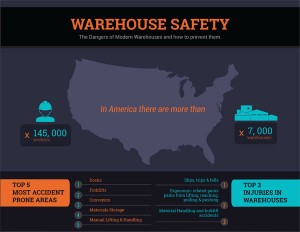 In the United States today there are more than 7,000 operational warehouses where more than 145,000 people go to work everyday. Ensuring that those warehouse workers go home safely at the end of their shift every day isn’t just the responsibility of management. Warehouse safety needs to be everybody’s concern.
In the United States today there are more than 7,000 operational warehouses where more than 145,000 people go to work everyday. Ensuring that those warehouse workers go home safely at the end of their shift every day isn’t just the responsibility of management. Warehouse safety needs to be everybody’s concern.
Keeping your warehouse safe is no easy task. There are lots of moving parts and always people and vehicles coming and going each day. But some areas of your warehouse are less safe than others. The top five most accident prone areas are the docks, forklifts, conveyors, materials storage and manual lifting and handling.
The docks offer more dangers than other areas of the facility because is where the most heavy vehicles will be coming and going, including tractor trailer trucks, delivery vans, forklifts, power jacks and other material handling equipment. Managing your dock for optimal safety requires keeping the area as clear of debris and as organized as possible, maintaining order among both your employees and outside delivery drivers, and enforcing the rules.
Docks also are often open to the elements so they can be effected by rain, snow and extreme temperature variations. In the winter, you can get a buildup of snow and ice that can make surfaces slippery and dangerous. In the summer, you can have extreme heat, sudden storms and the increased presence of bugs and other pests.,
Plus, docks are a prime location for thieves. Maintaining a high degree of security in your dock area will not only discourage crime, but also increase the overall safety of your warehouse.
Forklifts are heavy machinery and need to be always treated with respect both by their operators and the other employees in your warehouse. A forklift weighing several tons can cause a lot of damage to both your property and your employee’s physical well-being, so training and supervising your forklift operators at all times is essential.
Conveyors have moving parts that can easily catch on clothing, fingers, hair and other objects. This can result in crushing injuries which can lead to long-term health problems. Make sure your employees always keep a safe distance from conveyors whether or not they are running.
Materials storage areas often have very heavy loads being stored at very tall heights. So the opportunity for injuries of property damage due to falls is high. You can reduce the risk of accidents in materials storage areas by making sure all shelving is secure and properly maintained and through the use of safety guard rails and nets to prevent objects from falling on people or property below.
Finally, areas where manual lifting and handling are taking place offer the danger of lifting accidents, muscle pulls, crushing injuries and other potential danger. The best defense against these type of safety issues is through educating your employees on proper lifting techniques, using ergonomic equipment such as scissors lifts and lift gates to assist in lifting loads too heavy to lift by hand, and providing adequate supervision whenever employees are working with heavy loads.
